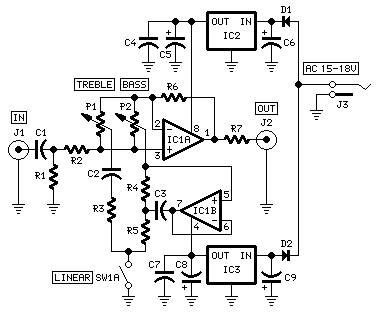Need a tone control, this module can be inserted into the chain between the Control Center and power amplifier. The circuit is based on an original design by Reg Williamson, published in Electronics World + Wireless World, circuit ideas, January 1991.
The tone control circuit will take the form of any of the traditional low treble adjustment, or the type of shelves, which is similar to a "tilt" control, but with separate bass and treble. Asymptotic slopes for both are about 4dB/octave, but begin to level off at 100 Hz and 10 kHz, with a maximum of ± 15 dB at the ends of the audio band.
Component values in parentheses are the shelving of control. In this case, the platform starts around 250 Hz and 4 kHz, flatten to a maximum of ± 6dB an octave above or below the central point is 1 kHz. Reactive elements for low-end includes a generalized impedance converter, which simulates an inductor in series with a resistor (spinner).
When set to the centers of their respective electrical controls, equalizers reactive elements are almost out of circuit. With these settings, the circuit behaves as a unity gain amplifier with 100% negative votes. Still, the reactive elements can be changed completely with a DPST on / off.
As with the other modules in this series, each electronic card can be fitted in a standard: Hammond extruded aluminum cases are well suited to accommodate the tables in this preamp. In particular, instances of size 16 x 10.3 x 5.3 cm or 22 x 10.3 x 5.3 cm look very good when stacked. See below an example of the possible arrangement of the front and back of this module.










